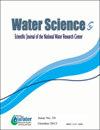Flow pattern formed over steps at a low-head dam: Salmon River Dam
Q2 Environmental Science
引用次数: 0
Abstract
Building Stepping way over the low-head dams has been proposed to reduce the risk of drowning in submerged flow conditions. In the Salmon Barrier, adding two steps downstream of weir was previously suggested as an effective method for reducing the risk of drowning downstream of this dam. Given the effect of steps on the flow pattern downstream of the weir, the occurrence of dangerous submerged flows at different tailwaters was predicted, and the flow pattern expected at variable tailwaters was studied in comparison with the flow pattern passing over the sharp crested weir. According to the results, the submerged flow pattern downstream of the dam is a combination of the submerged flow pattern over the abrupt drop at low tailwaters and that over the sharp crested weir at high water levels. Consequently, similar correlations for predicting the flow regime downstream of these structures can be presented to predict the flow pattern at different tailwaters. The flow pattern over the step was compared with that over the abrupt drop, and a few diagrams were presented for predicting the occurrence of different flow patterns based on the submergence ratio of steps. Given the similarity of the flow pattern with those in the literature for sharp crested weirs, the flow pattern was also investigated at higher tailwaters. The comparison of correlations developed in this study indicated that the flow pattern approaches that reported in the literature for sharp crested weirs with increasing discharge.在低水头大坝上形成的水流模式:鲑鱼河大坝
为降低淹没水流条件下低水头坝的溺水风险,提出了在低水头坝上设置阶梯式的建议。在鲑鱼屏障中,之前建议在堰的下游增加两个台阶,这是降低大坝下游溺水风险的有效方法。考虑台阶对堰下游流型的影响,对不同尾流发生危险淹没流进行了预测,并与尖顶堰经过尾流进行了对比研究。结果表明,三峡大坝下游的淹没流型是低尾水位陡降淹没流和高水位尖顶堰淹没流的结合。因此,预测这些结构下游流态的相似相关性可以用于预测不同尾流的流态。将台阶上的流型与陡坡上的流型进行了比较,并给出了几种基于台阶淹没比的流型预测图。考虑到尖顶堰的流型与文献的相似,本文还对高尾水的流型进行了研究。本研究发展的相关性比较表明,随着流量的增加,尖顶堰的流型接近文献报道的流型。
本文章由计算机程序翻译,如有差异,请以英文原文为准。
求助全文
约1分钟内获得全文
求助全文

 求助内容:
求助内容: 应助结果提醒方式:
应助结果提醒方式:


